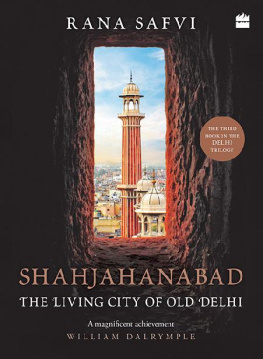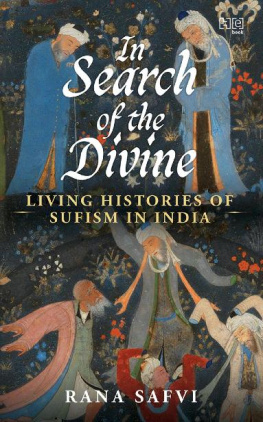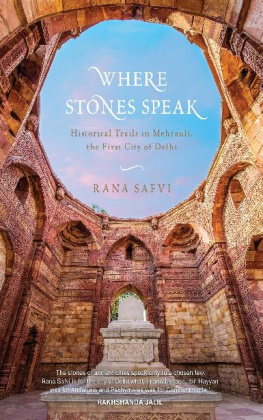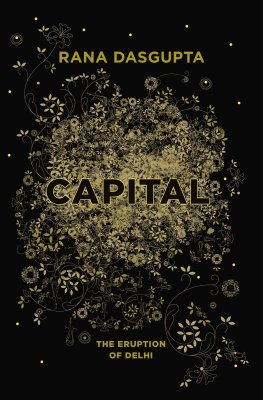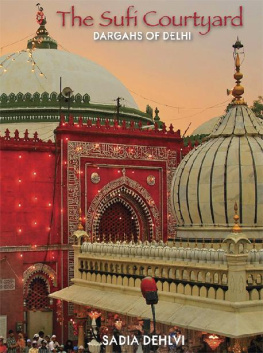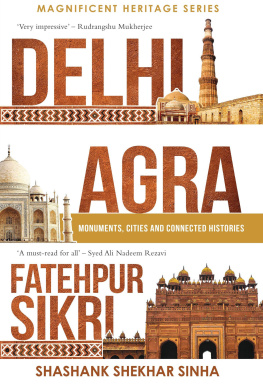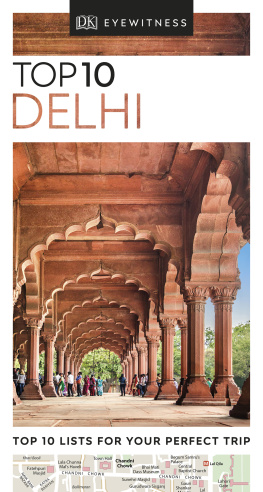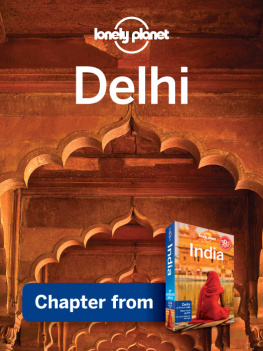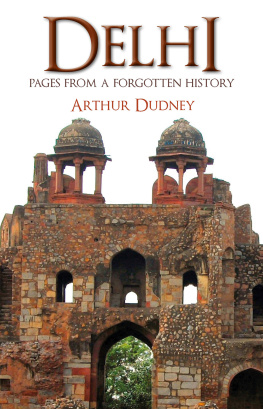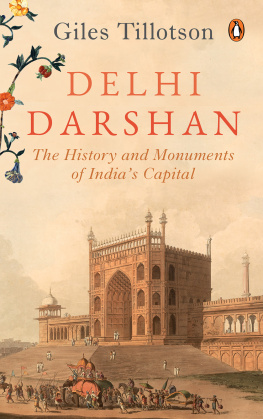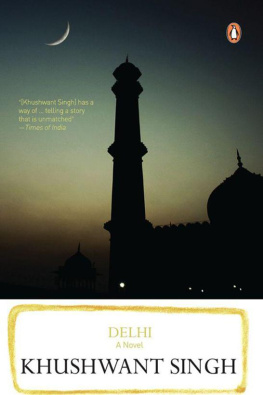Table of Contents
- Teen-Burj: Bare Khan ka Gumbad, Chote Khan ka Gumbad,
Bhure Khan ka Gumbad
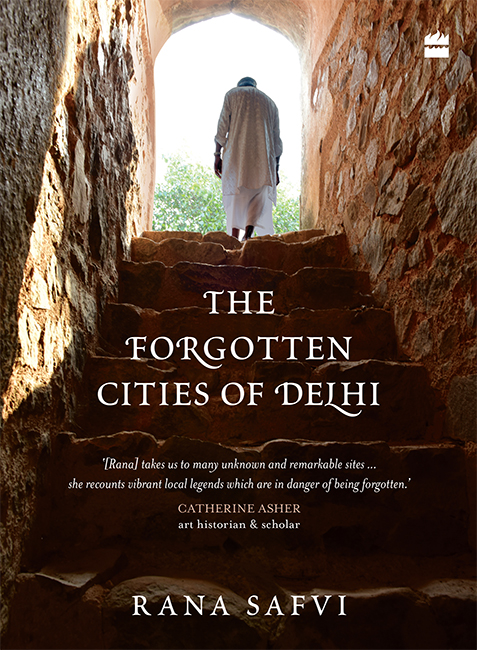
The
FO R gotten
Cities Of De L hi
Book Two in the
Where Stones Speak trilogy

rana safvi
Photographs
syed mohammad qasim

For Amma and Baba
We are what we are because you brought us up to be ourselves
to strive, to seek, to find, and not to yield
Contents
Teen-Burj: Bare Khan ka Gumbad, Chote Khan ka Gumbad,
Bhure Khan ka Gumbad
Maherbaan ho ke bulaa lo mujhe chaaho jis waqt
Main gayaa waqt nahin hun ke phir aa bhi na sakun
Be kind and call me whenever you please
Im not time past that I cant come with ease
Mirza Ghalib
Though today a contiguous whole, there are many cities within the city of Delhi. If we consider the Tomars as the first dynasty of whom we have documented proof, nine dynasties ruled Delhi till 1857 when it passed on to the hands of the British government, and Queen Victoria was crowned the Empress of India in 1877.
These dynasties were:
| Tomar | 10th century to 1179 |
| Chauhan | 1179-1192 |
| Ghori | 1192-1206 |
| Slave kings | 1206-1290 |
| Khilji | 1290-1320 |
| Tughlaq | 1320-1414 |
| Saiyyad | 1414-1451 |
| Lodi | 1451-1526 |
| Mughal | 1526-1857 |
| Sur | 1540-1556 |
Each of these dynasties either built a new capital city or expanded the existing one, giving Delhi a living history of over 1,500 years. There were various reasons for this, the primary one being the need to remain close to sources of water and building in areas with strong defensive positions. The cities therefore kept shifting northward until they culminated in Shahjahanabad.
This book covers the areas between the first city of Mehrauli and the last city of Shahjahanabad. Even today, this is a rich area as far as archaeological diversity is concerned all kinds of monuments, be they forts, masjids, mandirs, tombs and dargahs can be found all around.
Sultan Alauddin Khilji saw himself as Alexander the Second. He was a highly ambitious ruler with grandiose designs, many of which were left incomplete. The Delhi Sultanate reached its peak under him in terms of administrative prowess, but he couldnt conquer the world like Alexander, as he had to contend with insurrections within his kingdom and a very large threat from the Mongols. His ambitious schemes for his kingdoms architecture were left incomplete and he is known for the unfinished minar and the exquisite Alai Darwaza.
The advent of the Seljuq architects and artisans further fueled the demand for improved architectural skills and capabilities amongst Indian artisans, in turn leading to newer developments in the way kings went about constructing monuments and tombs. For example, Islamic geometrical patterns were woven into local traditions such as the lotus bud motif and the kalasa. Most mosques and tombs have the inverted lotus as its crowning glory with a finial on top. The lotus bud has been used as a decorative motif in many doorways from the thirteenth-century onwards, with the Alai Darwaza being the best example of it. This was a major step towards integration of two distinct cultures towards a culture now known as Indo-Islamic by many historians.
The Tughlaqs constructed three cities under three consecutive rulers. Sultan Firoz Shah was the most prolific of them all. He has the distinction of being the first conservator in India. He not only built new monuments but also repaired and renovated many of the old ones. He built five smart cities too!
The Tughlaq style was very austere, shorn of external ornamentation but built very solidly. Even Quranic calligraphy was missing in their monuments. If there was any painting on the walls it has not survived.
Sultan Firoz Shah built many buildings, namely hospitals, madarsas, shikargaahs, baolis and mosques. Seven of Delhis biggest mosques were constructed in his reign.
The Delhi Sultans built large congregational mosques in the Persian style, with a central open courtyard surrounded by cloistered halls (aiwans) on three sides with the fourth side being the main prayer hall. These were called four-aiwan mosques.
Calligraphy was profusely used as visible in the screens of Quwwat-ul-Islam mosque or the tomb of Sultan Iltutmish.
Art historian and scholar Catherine Asher says, A new theme was introduced in the inscriptions of Iltutmishs tomb, one that became especially important for the Mughals, that is, eternal paradise as a reward for the true believer of the Day of Judgment. Thus commences in India the tradition of paradisiacal imagery for tomb construction. Under the Mughals and culminating with the Taj Mahal, this theme came to be used with extraordinary effect, not only in inscriptions but in the entire conception of the monument.
Lodi kings were Afghans and in the Afghan tribal system the king was not considered divine or absolute. The nobles also felt that they deserved elaborate funerary buildings and thus in Delhi alone we had more than 100 tombs built under three Lodi kings. The only difference between royal tombs and tombs of nobles was not their size but shape. The royal tombs were generally octagonal while those of nobles were square in shape.
A unique feature of the Lodi tombs is the extensive calligraphy found on them, however none of them had their own names inscribed on them, which today leads to confusion in identifying the name of the person buried. Or if the names were written on a headstone, locals stole them for use in their own houses.
In fact, the name of Lodi Gardens was originally Bagh e Jadd (garden of the ancestors) and it was a funerary garden for the Lodis. Many accounts say that Sikander Lodi buried his father Bahlol Lodi in Bagh e Jadd. Basheeruddin Ahmed claims his tomb is located in Jodh Bagh, but I feel the name is a corruption of Bagh e Jadd and that may have extended all the way to Chiragh Delhi. This must be todays Jor Bagh, a residential colony.
Ive even came across a story stating that Jor Bagh is a corruption of Joru ka Bagh, as it was the estate of Nawab Qudsia Begum, the joru (wife) of Emperor Mohammad Shah (1719-48 AD). However, Professor Saiyyed Zahir Husain Jafri of the department of history at Delhi University rejects this theory. He says the word joru for wife was not a word in use in Delhi and no one would disrespect an empress this way. Another tidbit that hints that this theory could be factually incorrect is that most of her constructions, including the dargah at Shah e Mardan (built 1749-51 AD) in present-day Jor Bagh, happened during the reign of her son, Emperor Ahmad Shah Bahadur (r. 1748-54 AD) and not her husband.
The Lodi tombs bear strong resemblance to the Sharqi architecture of Jaunpur and it is possible that the Lodi Sultans brought artists from there after they vanquished the Sharqi kings.
Back then, tombs were part of a flourishing business as many enterprising merchants built tombs for sale and nobles bought these for their burial. That explains some empty tombs found today these were built but not sold. Locals who inhabited these places in the years that followed stole many of the tombstones and stones for reuse.


